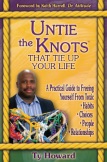Untie the Knots® of Your Public Speaking Jitters
(Nervousness and Fears)
Do you know someone whose stomach gets tied up in knots and bound down by jitters whenever they have to give a speech?
When it comes to public speaking, my friend Karen says without hesitation, “Every time I have to make a speech before an audience I get so nervous that my palms sweat, knees knock, hands shake uncontrollably, heart rate speeds up frantically, and the knots within my stomach become so intense that I think my mind will go blank and at some point I will pass out.”
Do you know someone who suffers from toxic public speaking knots (jitters, nervousness and fears), like my friend Karen?
You know what’s even worse: to have toxic public speaking jitters and not know how to break yourself free from them.
If this is you, do not hyperventilate or pass out just yet! Many people get nervous before giving a speech. This is a natural reaction but that does not mean you cannot do anything about it. There are ways for you to identify and break free of your public speaking jitters, fears and nervousness.
Here are nine reliable steps that will encourage and empower you to boldly Untie the Knots® of Your Public Speaking Jitters.
Step 1: Identify and acknowledge your specific toxic public speaking jitters.
In order for you to begin Untying the Knots® of Your Public Speaking Jitters, you must first sit down and write out on a blank sheet of paper a list of your known public speaking jitters. You can create this list by answering the following question, “What specific jitters, fears or nervousness come to me whenever I have to deliver a speech?” Your list should include all the jitters that come to you before you speak to an audience, while you’re speaking to an audience, and after you have spoken to an audience.
A few examples could be: 1) Before I speak to an audience – I get so nervous that I feel I will have nothing of any interest to share with the audience and the feeling pressures me to over prepare. 2) While I’m speaking to an audience – I get so nervous that my hands shake and I fear the audience wants me to fail. 3) After I have spoken to an audience – I feel that I’ve bored the audience and wasted their time.
Once you have completed your list of toxic public speaking jitters (knots), your next task is to write – a positive and healthy outcome statement – beside each jitter, fear or nervous item you wrote. A few examples could be: 1) I get so nervous that I feel I will have nothing of interest to share with the audience. Your – Positive and Healthy Outcome Statement – I care so much about the audience that I will have quality information to share with them. 2) I fear that the audience wants me to fail. Your – Positive and Healthy Outcome Statement – The audience participants are my friends and they want me to succeed. 3) I feel I bored the audience. Your – Positive and Healthy Statement – I gave the audience the best presentation possible, and I’ll do even better the next time I deliver a speech.
When you know what specific toxic public speaking jitters stand in your way, you can begin the process of Untying the Knots® of Your Public Speaking Jitters—beginning that day.
Step 2: Give yourself a confidence boost.
Now that you’ve begun the process of alleviating your toxic public speaking jitters (knots)—it’s time to give yourself a confidence boost. You have to envision and execute that vision of the person you’d like to be, do the things necessary and you will experience impressive public speaking success.
Confidence comes from competence (at least that’s one of the places it comes from). Set yourself up for success with an achievable goal. I suggest goals like feeding your mind with positive affirmations three times each day. Affirmations like: “I am a great person.” “I share interesting information the audience enjoys to receive from me.” “Public speaking is my friend.” Or give yourself several smaller goals, like spending fifteen minutes each day researching your speech subject matter, outlining your speech for simplicity, spending five minutes writing out the opening or conclusion of your speech, delivering a segment or two of your speech to a friend or co-worker, deciding on the clothes you’ll wear for your speech, or spending ten minutes each day reading something on effective public speaking/presentation skills. It doesn’t matter what your goals are. What matters is the feeling of satisfaction that comes from you setting out to do something, and then doing it.
Giving yourself a confidence boost is a great way to remind yourself daily how great a person you are. If you don’t, who will? Having self-confidence is necessary while Untying the Knots® of Your Public Speaking Jitters. Making a commitment with yourself begins with you believing in yourself and having faith that it will be done. It starts with the man or woman in the mirror.
Step 3: Plan and Prepare early.
Whenever you have to deliver a speech—it’s very wise for you to Plan and Prepare early. Quality planning and preparation are two of the major keys to public speaking success. Early planning and preparation allows you to 1) effectively research your speech topic, 2) outline and construct your researched information into a quality speech, 3) put together the best presentation game plan possible for the audience, and 4) speak impressively before the audience. When you know your speech topic and your presentation game plan, the journey you take the audience on will be one with confidence, passion and care.
Think for a moment of a public speaker that you heard in person and you walked away from the experience saying that was a great speaker with a great message. What were the specific things you saw and heard that made this public speaker a great speaker?
Through early planning and preparation the great orators (speakers) of today make public speaking look easy. You too can evolve to the same level of confidence and performance over time, if you work at it.
Step 4: Focus on the audience needs.
If you’re a first time or beginning public speaker whose stomach is already tied in knots due to toxic public speaking jitters―do not make the big mistake of failing to learn and focus on the specific needs of the audience as you put together your speech.
You can lessen most jitters, fears and nervousness by asking the person who asked you to speak the following three questions: 1) What would you like for me to talk about in my speech to your group? 2) What do you feel are four specific needs of your group as it pertains to this topic? 3) What are the things, trends or people you feel this audience best relates to today?
When you know the group you’re speaking to and why, your level of confidence and connection to the group will have you soaring high. It’s always about the audience’s needs, not yours.
Step 5: Keep your speech simple.
Another ultimate public speaking success goal you should strive for is to K.I.S.S. each and every audience. Keep It Simple Speaker!
Never be the speaker who tries to impress the audience by using a truck load of thirteen syllable words, by making too many points, by sharing too many facts, by being a quotation machine, and by presenting a speech that is both disjointed and confusing to follow.
It’s always win-win for the audience and you—when you to talk a lot about a little verses a little about a lot. In short, do not try to stuff ten pounds of potatoes into a five pound bag. K.I.S.S. the audience!
Step 6: Outline your speech for easy recall and flow.
Before you begin practicing and rehearsing your speech, outline your speech for easy recall and flow. Many novice public speakers with or without toxic public speaking jitters (knots) in their stomach create greater challenges for themselves by typing up and printing out every single word they plan to say in their speech.
When you type up, print out and intend to read word for word the pages that make up your speech, you are using the speech presentation method of reading an article. Articles are meant to be read, and speeches are meant to be said (spoken smoothly).
I’m not saying for you to not have notes to help guide and assist you. I am suggesting for you to use my 3 x 5 index card speech outline system with a few additional coaching tips. This will move you confidently from the public speaker who is reading an article to the audience to a public speaker who is connecting and speaking smoothly to the audience. Here’s how you’re to outline your speech using my 3 x 5 index card speech outline method.
Break your speech up into the following segments:
Index Card 1) – Your Speech Opening
Index Card 2) – Body (Your Purpose Statement and What
You’re Going to Speak About…)
Index Card 3) * Main Point 1
Index Card 4) * Main Point 2
Index Card 5) * Main Point 3
Index Card 6) Quick Recap of Your Main Points
Index Card 7) – Your Speech Conclusion
Your index cards should be numbered in sequential order. Put the same number on both the front and back of the index card just in case you mistakenly drop them. Use a hole-puncher to punch a hole in the upper right-hand corner of each index card. Place self stick paper reinforcements on both the front and back of the index card to make the hole that you punched on the index card sturdy. Now combine and hold the small stack of index cards together using a small metal keychain ring.
Write just enough information on one side of the index card that will help you to recall and flow smoothly with the information you plan to share with the audience. Do not try to write your speech out word for word on the index cards! A speech is meant to be said, not read word for word.
Practice! Practice! Practice! You will be surprised when you feel, hear and see how much more effective you are using my 3 x 5 index card speech outline method.
Step 7: Rehearse your speech in chunks.
It’s been said time and time again, “The best way to eat an elephant is one bite at a time.”
With that said, “Why do first time and beginning public speakers continuously make the mistake of trying to learn and rehearse their speech from beginning to end?” Because they have never learned or do not know any other way to rehearse and practice a speech.
Instead of rehearsing your speech in its entirety, from beginning to end, this time try it in chunks (segments). Using my index card system in Step 6, rehearse your speech using this modified index card speech practicing order:
Index Card 1) – Your Speech Opening
Index Card 7) – Your Speech Conclusion
Index Card 2) – Body (Your Purpose Statement and What
You’re Going to Speak About…)
Index Card 3) * Main Point 1
Index Card 4) * Main Point 2
Index Card 5) * Main Point 3
Index Card 6) Quick Recap of Your Main Points
You should always know the opening and conclusion of your speech cold. Why? Because people will remember the first thing and the last thing you say. The body is important too; however, if for some unknown reason the time you’ve been allotted to speak is cut short, using the chunking rehearsal method you’re to remove one of your “*Main Point Index Cards”. Which means, instead of making three main points, you will only make two main points.
Practice! Practice! Practice! You will be surprised when you feel, hear and see how much more effective you are using the chunking speech rehearsal and practice method.
Step 8: Arrive at the speech location early, looking the part and expecting success.
On the day of your speech presentation, try to be the first person to arrive inside the room where you will be presenting. This will give you time to see the area you will be speaking in, and time to setup, test the equipment (microphone, props, sound system, etc.), and move things around if needed. It will also give you a chance to calm your jitters, fix your clothing, and visualize yourself succeeding with the audience in this environment.
To successfully Untie the Knots® of Your Public Speaking Jitters so you can make great things happen when you speak to an audience—you must visualize… plan… prepare… practice… believe… and act!
Step 9: Journal your public speaking experiences.
Writing removes mental blocks and allows you to use all of your brainpower to better understand yourself, others and the world around you. Begin journaling about what happens to you before, during and after you deliver a speech and you will begin experiencing these benefits: knowing yourself better; clarity on your thoughts and feelings; reduced jitters and nervousness; and the confident ability to face and alleviate your public speaking fears more quickly and effectively.
Life experiences carefully recorded become life experiences available in time of need.
Keeping a journal allows you to track patterns, trends and improvement and growth over time. When current toxic public speaking jitters appear insurmountable, you will be able to look back on previous public speaking jitters that you have since resolved.
Feeling jitters or nervousness at the thought of giving a speech is common, particularly if you do not give speeches often. Thorough self-examination on what your specific jitters are and having the courage to address and break yourself free from them is the key to reducing your public speaking jitters and nervousness levels. Untying the Knots® of Your Public Speaking Jitters will take some time, but it can be accomplished through practice and experience. Continuously apply the nine reliable steps above and I assure you that the best speech you will ever give is your next speech!
Remember —
The Public Speaking Jitter Knots May Test You,
Leaving Your Stomach Feeling Nervous and Queasy Inside.
Don’t Faint! Never Quit! Keep Going!
You’ve May Have Been Delayed, But You’re RARELY Denied.
Begin your process today—Untie the Knots® of Your Public Speaking Jitters!
About the Author: Ty Howard,
Mr. Untie the Knots®,
Freeing Maximal Business, Performance & Human Potential Daily!
Ty Howard is an internationally recognized authority on personal and relationship development. He is the creator and lead facilitator of the trademarked “Untie the Knots® Personal Performance Process,” and the author of the best-selling book Untie the Knots® That Tie Up Your Life: A Practical Guide to Freeing Yourself from Toxic Habits, Choices, People, and Relationships, as well as dozens of published articles on relationships, healthy habits development, empowerment and peak performance worldwide.
To learn about Ty Howard’s Public Speaking and Presentation Skills Coaching and Training services, visit: http://www.PublicSpeakerCoaching.com.
Click Here for MORE Ty Howard Quotations & Sayings
















